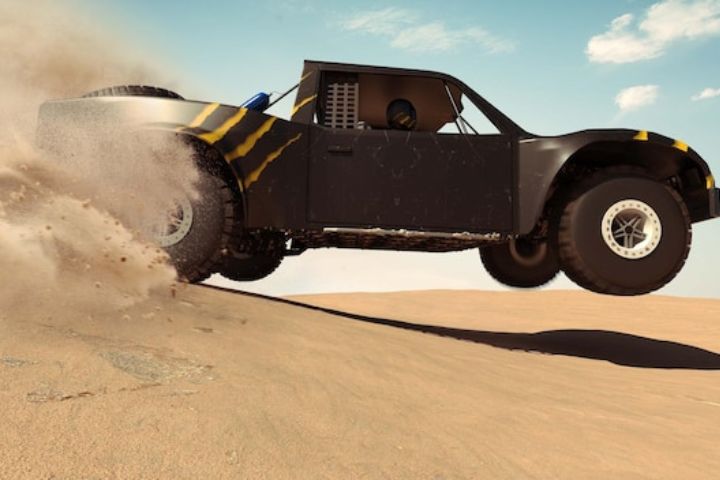
Why Does My RC Car Go By Itself? Have you ever seen a remote-controlled car zipping down the street by itself? It can be quite a sight – one moment everything is quiet, then suddenly a small car appears from around the corner! Autonomous cars are still a ways off, but RC cars have gotten pretty close. With an increasing range and intelligent programmability, they’re capable of doing some pretty impressive things. One of these is navigating on their own in high-traffic areas while avoiding obstacles in their path. What’s more, thanks to modern technology it’s possible to achieve this with relative ease – anyone can now purchase an RC car that goes by itself and enjoy its capabilities.
The Basics of How RC Cars Work
RC vehicles, also known as radio-controlled cars, are powered by a combination of a small electric motor, batteries, and a radio-controlled system, which allows the driver to direct the movement of the vehicle. The motor, which is responsible for turning the wheels and moving the vehicle ahead, receives its power from the car’s battery. The radio-controlled system consists of a transmitter, which is the controller that the user holds, and a receiver, which is housed within the automobile. The receiver is what receives signals from the transmitter and then delivers them to the motor so that the user can control the movement of the car. The receiver receives signals from the transmitter that tell it how fast to drive the automobile in each of the four directions (forward, backward, left, or right) as well as which direction to move it in. The receiver then applies its meaning to these signals and transmits the correct amount of power to the motor so that the automobile can move.
Related post: How Do RC Cars Work
Why Does My RC Car Go By Itself?
There are a few potential explanations for why your remote-controlled automobile is driving without your input:
Dead Batteries
Dead batteries in your remote-controlled car can be a major headache, leading to some unexpected and unwanted surprises. When the battery life runs out, the controller’s signal is no longer sent to the car. The result is that instead of stopping, the car continues to zip around in random directions, losing control and often colliding with walls or other objects. This experience can be rather surprising, but also quite scary – when we witness it for ourselves, as what was once within our control suddenly escapes it. To prevent these occurrences from happening, make sure you remember to check your battery levels before taking up the controller. If the batteries in your transmitter or car are low or dead, the car may not respond correctly to your directions and may move on its own. Additionally, the car may move on its own if the batteries in the transmitter are low.
Interference
It’s an annoyance every radio-controlled car owner has experienced: the RC car suddenly takes off by itself, navigating wildly until it accidentally crashes into something. It turns out these peculiar occurrences can be caused by frequency interference — when two RC cars with similar frequencies or a nearby radio or cell phone transmission hijack the signal to your device. This can cause RC Cars to start and stop suddenly and strongly veer off course from their operators’ intended direction. Other radio-controlled types of equipment in the vicinity may be generating interference with the signal that is being sent between your transmitter and receiver, which is allowing your automobile to move on its own without your input. Luckily, there are ways to reduce the likelihood of interference with your device thanks to prevention methods like channel binding remote controls with the receiver and switching channels when encountering interference.
Damaged Receiver or Transmitter
If you have ever experienced an RC car suddenly going on its own while playing with it, it could be due to a damaged receiver or transmitter. Both receivers and transmitters are sensitive components of the RC car, and when they are faulted, your vehicle can move erratically. If the receiver malfunctions, then the signals coming from the transmitter cannot be properly read and interpreted by the car causing it to speed off. On the other hand, if the transmitter has been damaged then inconsistent signal frequency could be sent which also causes control irregularities in your RC car. If you find your vehicle unexpectedly running off make sure to check both components to identify which one has been contaminated. In the event that either the receiver or the transmitter is broken, it is possible that the device may not send or receive signals correctly, which will result in the automobile moving on its own.
Stuck Throttle or Steering
It’s an unsettling feeling when an RC car begins to take off by itself, as both throttle and steering controls appear to be unresponsive. It can happen for a number of reasons, but the most common is stuck throttle control. This can be caused by debris getting lodged in the accelerator or by general wear and tear on the components. Another possible explanation is a jammed servo, the component which connects your RC’s remote control to a particular function, like accelerating or steering left. If the steering wheel or throttle on your vehicle becomes jammed, the vehicle may continue to go in the same direction even if you are unable to operate it. Fortunately, these issues are usually fixable with some simple repairs or replacements. With an upgraded servo or properly cleaned throttle mechanism, those out-of-control moments should no longer be a problem.
Auto Shut Off Feature
The Auto Shut-Off feature found in many types of remote-controlled (RC) cars can be both a godsend and a nightmare. It allows the vehicle to auto shut off if it is going out of control, eliminating the risk of injury or property damage. However, there have been reported instances when the auto shut-off process has gone awry, resulting in RC cars that start-up and operate unexpectedly on their own. A combination of factors can lead to this issue, including insufficient run time and a sensor misinterpreting signals from its environment. As such, users should always make sure their vehicles are running properly before putting them into operation. Some radio-controlled cars contain a function called “auto shut off” that disables the vehicle if it has not been used for a predetermined amount of time. It is possible that this feature if it is present in your vehicle, is causing it to turn on by itself.
It is recommended that you check and replace the batteries, transfer your car to a different location, check the condition of your transmitter and receiver, and ensure that the throttle and steering are not stuck in any position. If the issue continues, you might want to refer to the user manual provided by the manufacturer or get in touch with the manufacturer for assistance.
Types of RC Cars Interference
Chain Link Fences
Driving an RC car can be a fun and entertaining pastime, but their small size can cause some issues–especially when it comes to chain link fences. Even if the driver can navigate around the metal links of the fence, the necessary radio frequency can be interfered with by any number of objects and create some serious disruption for the driver. Fortunately, there is a way to prevent this interference: adding shielding tape to both your transmitter and receiver should block out any interfering frequencies. Keeping your RC car from getting stuck on even the biggest chain link fences is as easy as that!
CB Radio Signals
Radio-controlled cars and CB radio signals often exist in the same space, but little do most people know of the potential interference that can be caused by this overlap. Depending on the type of equipment used, it is possible to experience a wide range of interference levels. In some cases, sound may be distorted, while in other cases RC car operations may be hindered or stopped as a result of radio transmission. To prevent such disruption and prevent damage to either device, it’s important to determine what type of equipment is being used and create boundaries between them. With proper safety precautions and understanding, RC car operators and CB radio users can coexist peacefully without one disrupting the other.
Radio or TV Antennae
RC car owners who use radio control to maneuver cars around often have to worry about interference from external sources like television and radio antennae. This is especially true for those living in big cities or near airports, broadcasting stations, or other areas likely to cause disruption. Luckily, there are a few ways to battle this interference. Shielded antennas are an effective way of combating existing noise from nearby radio sources while changing the frequency band may help if it is found that competing signals on a similar frequency exist. Furthermore, the use of light-based RC car control can almost completely get rid of the issue of signal interference because variable frequencies do not need to be changed as often. Ultimately, understanding and addressing vibrations transmitted by external sources is essential for RC car owners who want trouble-free control over their vehicle’s movement.
Neon or Fluorescent Lights
Racing a remote control (RC) car can be just as fun and competitive as the real thing, but there is one issue that comes up when neon or fluorescent lights are used- interference. The flickering lights can negatively impact the electrical signals in an RC car’s transmitter, preventing drivers from controlling their vehicles. Though it may not always be possible to avoid fluorescent lighting, taking steps like installing a receiver shield or using a radio frequency filter help to minimize interference so RC racers are still able to move around the track.
Steel Structures
Steel Structures, like those used in remote control (RC) cars, can create electromagnetic interference when placed near transmitter antennas. This causes problems for many RC car racers who want to use their vehicles on a steel structure track because the signal between the car and control is blocked by the metal of the structure which makes it hard for them to maintain control. Luckily, there are ways to minimize this issue with the use of filters that block out interference and other solutions like moving transmitters closer to where the car will race. RC car racers must bear these considerations in mind when choosing a track so they can minimize any interference created by steel structures if they want to get an optimal racing experience.
Avoiding RC Cars Interference
To ensure your remote-controlled (RC) cars don’t suffer from interference, you should try to reduce the number of outside radio signals and have as much control over your RC car as possible by using a dedicated radio frequency that is not in used by other devices. For this, it’s important to find the best area with little radio interference, which could be an open field or a large area away from buildings or other electronic equipment. Additionally, make sure all of your RC controllers are equipped with safety features that prevent them from operating when someone else is controlling their model at the same time. Taking these steps can help reduce any unwanted interference and set you up for a successful and interference-free RC car experience.
The Future Of RC Car Technology
The technology that underpins RC cars is perpetually advancing, and there have been several recent advancements that are expected to have a significant impact on the sector’s future. The following are examples of developments that are anticipated to have a significant effect in the not-too-distant future:
- Improved radio-controlled systems: New radio-controlled systems are now being developed, and these new systems will have higher interference resistance in addition to increased control and range capabilities.
- Autonomous driving: Using sophisticated sensors and complex algorithms, researchers are attempting to create remote-controlled cars that are capable of driving themselves. This would make it possible to compete in races and other contests with completely autonomous vehicles.
- Virtual reality and augmented reality integration: It’s likely that, as virtual reality (VR) and augmented reality (AR) technology continues to progress, RC cars will be able to interface with these technologies, allowing for more immersive experiences.
- Connectivity: It is anticipated that radio-controlled automobiles will become increasingly linked as the Internet of Things (IoT) and 5G networks continue to develop. This will make it possible to do tasks such as real-time tracking, remote control, and other functions.
- Increased use of 3D printing: Because 3D printing technology is getting more sophisticated and affordable, it may soon be possible for RC vehicle fans to print their parts and increase the degree to which RC cars can be customized.
These technological breakthroughs will add more fun and excitement to the hobby, as well as open up new opportunities for contests, racing events, and other activities that include RC cars. RC car enthusiasts will be able to look forward to these developments.
Also Read: Rc Car Not Responding to Controller
Conclusion
Watching an RC car glide by on its own is an incredibly fun experience. With the click of a button, the car takes off, zooming around and performing stunts without human guidance. How does it do this? These EVs come equipped with a pre-programmed microcontroller that can automatically adjust speed, and direction, and perform advanced movements like drifting and flips by monitoring the environment and making split-second decisions based on commands from the driver. It’s impressive to see this technology at work, so much potential packed into something as small as a toy car.


